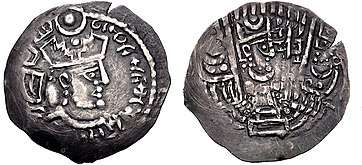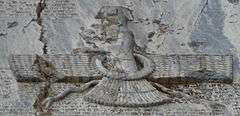Sogdian city-states
The Sogdian city-states refers to a number of independent or autonomous city-states in Iranian region of Sogdia in the late antiquity and medieval times.[1] Most of the city-states were ruled by a king or queen, who was called "first among equals".[2] However, the succession of rule was not stable, and the people could influence who would become the new ruler.[2] The period, which experienced its peak in the 7th century, ended with the conquest of Transoxiana by the Islamic Caliphate.[1]

Coin of Khunak, one of the rulers of Bukhara.
Bukhara and Samarkand – the famous cities of Persian literature – were the largest and wealthiest Sogdian states.[1]
Part of a series on the |
|---|
| History of Tajikistan |
| Timeline |
|
|
See also
References
- Marshak, B. I. 1996. ‘Sughd and Adjacent Regions’. In B. A. Litvinsky (ed.), Co-editors: Zhang Guang-da and R. Shabani Samghabadi. History of Civilizations of Central Asia. The Crossroads of Civilizations: A.D. 250 to 750. Volume III. Paris: UNESCO. p.242
- De la Vaissière, E. 2005. Sogdian Traders: a History. Translated by James Ward. Leiden; Boston: Brill. p.167
This article is issued from Wikipedia. The text is licensed under Creative Commons - Attribution - Sharealike. Additional terms may apply for the media files.
